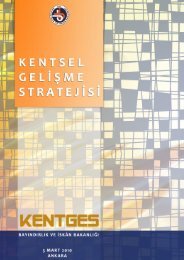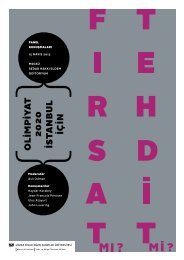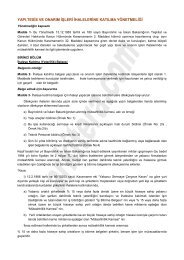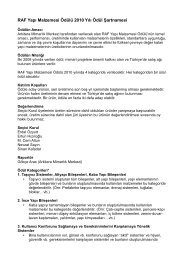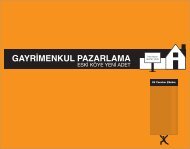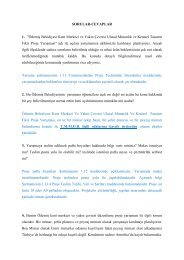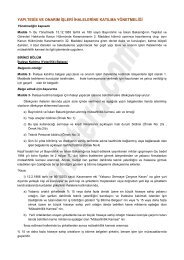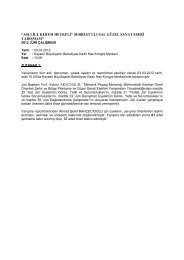VitrA ÃaÄdaÅ Mimarlık Dizisi - Arkitera
VitrA ÃaÄdaÅ Mimarlık Dizisi - Arkitera
VitrA ÃaÄdaÅ Mimarlık Dizisi - Arkitera
You also want an ePaper? Increase the reach of your titles
YUMPU automatically turns print PDFs into web optimized ePapers that Google loves.
This project is all about İstanbul. The two legs of the U-shaped layout represent the<br />
European and Anatolian sides of the city. In between the two sides, there is a large<br />
pool that symbolizes the “Bosphorus”, with the “Maiden’s Tower” in between. There is<br />
a channel at the side of the pool for the sultan’s boats. The two sides are connected<br />
by the “Da Vinci” bridge. The main entrance of the hotel that houses the reception and<br />
the lobby under an impressive vault is located at the “Dolmabahçe Palace”. The ground<br />
level of Dolmabahçe Palace has been designed as the “Grand Bazaar”, an arched structure<br />
in accordance with the original, intended to house the shops of prestigious brands.<br />
Haydarpaşa and Beşiktaş Piers were designed to for restaurant use. In addition, the<br />
lower levels house a 7.500 m² spa center with a rain forest theme.<br />
✎<br />
As a consequence of changes in the tourism investment policies of Turkey, the Council<br />
for the Conservation and Preservation of Cultural and Natural Assets decided in 1984<br />
to decrease the borderline for the natural coast protection zone from 150 meters to<br />
35 meters. Following this change, agricultural areas and natural and historical zones that<br />
were formerly protected were rapidly transformed and filled up by tourism facilities,<br />
accelerated further by the law for “The Promotion of Tourism Investments”. 8,5 kilometers<br />
long and 150 meters wide, the Lara cliff coastline located to the east of Antalya and<br />
1,5 kilometers from the Kundu coastline is surrounded by dunes and pine forests, and<br />
has been declared a “Zone of Preservation and Development of Culture and Tourism”,<br />
thus opening the area to tourism investments. Mardan Palace Hotel is located within<br />
this region called the “Kundu Tourism Facilities Zone”, on the coast of Kundu village<br />
20 kilometers away from Antalya Airport, between the streams of Aksu and Acısu,<br />
where the most luxurious tourism facilities of Turkey are lined up side by side, away<br />
from urban environments.<br />
With its fictional references and ultra-luxurious services, Mardan Palace Hotel, which<br />
was initially called Safisa Istanbul & Istanbul Palace, is one of the most striking examples<br />
of the post-modern approach that has brought the “palace” to the agenda of thematic<br />
hotels. Similar to thematic parks, the complex with the theme “Istanbul” was<br />
designed as a collage of well-known images detached from their contexts, including<br />
easily re-cognizable symbols and buildings combined in a fictional construction.<br />
The buildings remind the user of Dolmabahçe Palace, Moda, Beşiktaş Piers and the<br />
Maiden’s Tower, areas representing the Anatolian and European districts and the Bosphorus.<br />
The indoor shopping area was inspired by the Grand Bazaar, and even Leonardo<br />
da Vinci’s unbuilt bridge designed for the Golden Horn has been included in this idealized<br />
fictional Istanbul.<br />
These non-places serve post-tourist users who have lost their expectations for authenticity<br />
and reality and are aware that everything is fictional. These users have a neverending<br />
demand for consumption, pleasure and fantasy. With their phantasmagoric and<br />
fictional properties, these spaces are signs of the structural transformation that tourism<br />
is undergoing.<br />
110<br />
1<br />
2



